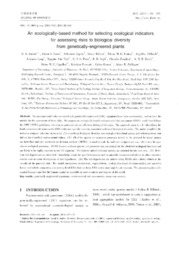An ecologically-based method for selecting ecological indicators for assessing risks to biological diversity from genetically-engineered plants.
An ecologically-based method for selecting ecological indicators for assessing risks to biological diversity from genetically-engineered plants.
Autoria: ANDOW, D. A.; LOVEI, G. L.; ARPAIA, S.; WILSON, L.; FONTES, E. M. G.; HILBECK, A.; LANG, A.; TUAT, N. V.; PIRES, C. S. S.; SUJII, E. R.; ZWAHLEN, C.; BIRCH, A. N. E.; CAPALBO, D. M. F.; PRESCOTT, K.; OMOTO, C.; ZEILINGER, A. R.
Resumo: The environmental risks associated with genetically-engineered (GE) organisms have been controversial, and so have the models for the assessment of these risks. We propose an ecologically-based environmental risk assessment (ERA) model that follows the 1998 USEPA guidelines, focusing on potential adverse effects to biological diversity. The approach starts by (1) identifying the local environmental values so the ERA addresses specific concerns associated with local biological diversity. The model simplifies the indicator endpoint selection problem by (2) classifying biological diversity into ecological functional groups and selecting those that deliver the identified environmental values. (3) All of the species or ecosystem processes related to the selected functional groups are identified and (4) multi-criteria decision analysis (MCDA) is used to rank the indicator endpoint entities, which may be species or ecological processes. MCDA focuses on those species and processes that are critical for the identified ecological functions and are likely to be highly exposed to the GE organism. The highest ranked indicator entities are selected for the next step. (5) Relevant risk hypotheses are identified. Knowledge about the specific transgene and its possible environmental effects in other countries can be used to assist development of risk hypotheses. (6) The risk hypotheses are ranked using MCDA with criteria related to the severity of the potential risk. The model emphasizes transparent, expert-driven, ecologically-based decision-making and provides formal methods for completing a screening level-ERA that can focus ERA on the most significant concerns. The process requires substantial human input but the human capital is available in most countries and regions of the world.
Ano de publicação: 2013
Tipo de publicação: Artigo de periódico
Observações
1 - Por padrão são exibidas publicações dos últimos 20 anos. Para encontrar publicações mais antigas, configure o filtro ano de publicação, colocando o ano a partir do qual você deseja encontrar publicações. O filtro está na coluna da esquerda na busca acima.
2 - Para ler algumas publicações da Embrapa (apenas as que estão em formato ePub), é necessário ter, no celular ou computador, um desses softwares gratuitos. Sistemas Android: Google Play Livros; IOS: iBooks; Windows e Linux: software Calibre.
Acesse outras publicações
Acesse a Base de Dados da Pesquisa Agropecuária (BDPA) para consultar o acervo completo das bibliotecas da Embrapa.

